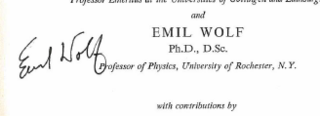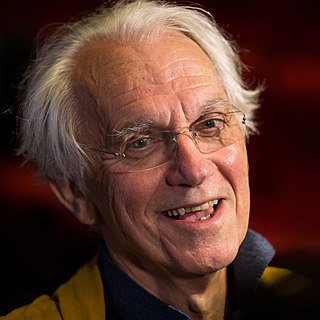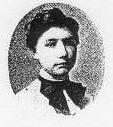
The Optical Society (OSA) is a professional association of individuals and companies with an interest in optics and photonics. It publishes journals, and organizes conferences and exhibitions. In 2019 it had about 22,000 members in more than 100 different countries, including some 300 companies.

Emil Wolf was a Czech-born American physicist who made advancements in physical optics, including diffraction, coherence properties of optical fields, spectroscopy of partially coherent radiation, and the theory of direct scattering and inverse scattering. He was also the author of numerous other contributions to optics.
Naomi J. Halas is the Stanley C. Moore professor in Electrical and Computer Engineering, professor of Biomedical Engineering, Chemistry, Physics & Astronomy, and director of Laboratory for Nanophotonics at Rice University. She has been elected to the American Academy of Arts and Sciences (2009), National Academy of Sciences (2013) and National Academy of Engineering (2014).

Adelbert Ames Jr. was an American scientist who made contributions to physics, physiology, ophthalmology, psychology, and philosophy. He pioneered the study of physiological optics at Dartmouth College, serving as a research professor, then as director of research at the Dartmouth Eye Institute. He conducted important research into aspects of binocular vision, including cyclophoria and aniseikonia. Ames is perhaps best known for constructing illusions of visual perception, most notably the Ames room and the Ames window. He was a leading light in the Transactionalist School of psychology and also made contributions to social psychology.

Gérard Albert Mourou is a French scientist and pioneer in the field of electrical engineering and lasers. He was awarded a Nobel Prize in Physics in 2018, along with Donna Strickland, for the invention of chirped pulse amplification, a technique later used to create ultrashort-pulse, very high-intensity (petawatt) laser pulses.
SPIE is an international not-for-profit professional society for optics and photonics technology, founded in 1955. It organizes technical conferences, trade exhibitions, and continuing education programs for researchers and developers in the light-based fields of physics, including: optics, photonics, and imaging engineering. SPIE is most known for Photonics West, held in San Francisco.
Kenneth N. Ogle (1902-1968) was a scientist of human vision. He was born in Colorado, and attended the public school and college at Colorado Springs. In 1925, Ogle earned a bachelor's degree from Colorado College cum laude. After graduation from college and selection of physics as a career, Ogle spent two years at Dartmouth College, a year at the University of Minnesota, and then returned to Dartmouth College for his Ph.D. degree, awarded in 1930. He was later awarded an honorary medical degree by the University of Uppsala in Sweden.
Leonard Mandel was the Lee DuBridge Professor Emeritus of Physics and Optics at the University of Rochester when he died at the age of 73 at his home in Pittsford, New York. He contributed immensely to theoretical and experimental optics. With Emil Wolf he published the highly regarded book Optical Coherence and Quantum Optics.
Ken Nakayama is an American psychologist and the Edgar Pierce Professor of Psychology at Harvard University. He is well known for his work on prosopagnosia, an inability to recognize faces, and super recognisers, people with significantly better-than-average face recognition ability.

Brian A. Wandell is the Isaac and Madeline Stein Family Professor at Stanford University, where he is Director of the Stanford Center for Cognitive and Neurobiological Imaging, and Deputy Director of the Wu Tsai Neuroscience Institute.
The Journal of Optics is a peer-reviewed scientific journal covering all aspects of modern and classical optics, experimental and theoretical studies, applications and instrumentation. It is the official journal of the European Optical Society and is published by IOP Publishing. The editor-in-chief is Nikolay I. Zheludev. According to the Journal Citation Reports, the journal has a 2018 impact factor of 2.753.

The University of Arizona College of Optical Sciences, considered the largest institute for optics education in the United States, is dedicated to research and education in optics with an emphasis on engineering. The college focuses on providing solutions for the optics industry worldwide by initiating internationally recognized research programs and offering more than 90 courses in optical sciences. The college offers a Bachelor of Science degree in Optical Sciences and Engineering, Masters and Doctoral degree programs in Optical Sciences, as well as a dual master's degree in Optical Sciences and Business Administration. The college also offers comprehensive distance learning courses leading to a Professional Graduate Certificate or a master's degree and markets non-credit short courses on DVD to optics professionals.
Robert Earl Hopkins was president of the Optical Society of America in 1973.
Yuen-Ron Shen is a professor emeritus of physics at the University of California, Berkeley, known for his work on non-linear optics. He was born in Shanghai and graduated from National Taiwan University. He received his Ph.D. in Applied Physics from Harvard under physicist and Nobel Laureate Nicolaas Bloembergen in 1963, and joined the department of physics at Berkeley in 1964. In the early years, Dr. Shen was probably best known for his work on self-focusing and filament propagation of laser beams in materials. These fundamental studies enabled the creation of ultrafast supercontinuum light sources. In the 1970s and 1980s, he collaborated with Yuan T. Lee on the study of multiphoton dissociation of molecular clusters. The molecular-beam photofragmentation translational spectroscopy that they developed has clarified much of the initial confusion concerning the dynamics of infrared multiphoton dissociation processes. In the 1980s and 1990s, Professor Shen developed various nonlinear optics methods for the study of material surfaces and interfaces. Among these techniques, second-harmonic generation and sum frequency generation spectroscopy are best known and now widely used by scientists from various fields. He has collaborated with Gabor Somorjai on the use of the technique of Sum Frequency Generation Spectroscopy to study catalyst surfaces. He is the author of the book The Principles of Nonlinear Optics. Professor Shen belongs to the prolific J. J. Thomson academic lineage tree. Currently, Professor Shen works in U. C. Berkeley and Fudan University in Shanghai.
Marie Gertrude Rand Ferree was an American research scientist who is known for her extensive body of work about color perception. Her work included "mapping the retina for its perceptional abilities", "developing new instruments and lamps for ophthalmologists", and "detection and measurement of color blindness". Rand, with LeGrand H. Hardy and M. Catherine Rittler, developed the HRR pseudoisochromatic color test.

Miles John Padgett, is Professor of Optics in the School of Physics and Astronomy at the University of Glasgow. He has held the Kelvin Chair of Natural Philosophy since 2011 and has been Vice Principal for Research at Glasgow since 2014.
Leo Maurice Hurvich was an American psychologist who conducted research into human color vision. He was married to fellow cognitive psychologist Dorothea Jameson. The pair collaborated on much of their work, including an elaboration on the opponent process theory. Hurvich was a member of the National Academy of Sciences and he received the APA Award for Distinguished Scientific Contributions to Psychology from the American Psychological Association.

Anna Estelle Glancy was an astronomer, computer and lens designer whose work with Edgar Tillyer at the American Optical Company improved the optics of eyeglasses, cameras, telescopes, and military optical instruments. She was born and died in Waltham, Massachusetts.

Pablo Artal is a Spanish physicist and full professor specialized in optics at the University of Murcia, as well as in the development and application of new techniques in human vision research. He received the 'Rey Jaime I' Award for New Technologies in 2015. His main research topics are the optics of the eye and the retina and the development of optical and electronic imaging techniques in the field of biomedicine, ophtalmology and vision. He has contributed to the advance of methods for the study of the optics of the eye and contributed to the understanding of the factors that limit the resolution of the human vision. Moreover, his discoveries and ideas have been applied to instruments and devices used in the clinical practice of ophthalmology.
Fergus William Campbell was a Scottish vision scientist who conducted foundational research into the optics of the human eye, into the electrical activity of the brains of people experiencing various phenomena of vision, and into the sorts of images which, when shown to people, might reveal the processes of their visual systems. Campbell's research changed the course of vision science.









